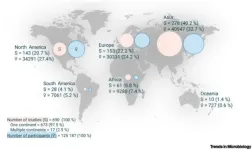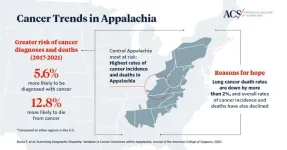(Press-News.org) Vaginas host a complex microcosm of bacteria and yeasts that can fluctuate over time. However, little is known about these microbial communities and their roles in a person’s health, and 9 out of 10 studies only include participants from one continent, resulting in major geographical gaps in data. In a paper publishing February 6 in the Cell Press journal Trends in Microbiology, scientists share insights gleaned from a “sisterhood” of thousands of citizen scientists and demonstrate how international collaboration can help illuminate the gaps in our knowledge about the vaginal microbiome, including which bacteria are helpful or harmful and whether microbiomes look different for people across the globe.
“Women’s health is essential to global societal and economic wellbeing, yet health disparities remain prevalent,” write the researchers, comprised of scientists from 4 continents and 9 countries, including lead author Sarah Lebeer (@SarahLebeer) of the University of Antwerp in Belgium. “Women’s bodies, and knowledge concerning their health have been neglected, controlled, and persecuted for centuries, resulting in a health disparity that persists today.”
The authors are involved in citizen science initiatives called the Isala Sisterhood, which aim to inspire research on women’s health and microbiomes worldwide by creating a reference map of vaginal microbiota. Originally launched in Belgium as the Isala Project with over 6,000 participants, the Isala Project has grown into a “sisterhood” including microbiologists, health care workers, governmental organizations, and the public, and branched out across North America, South America, Asia, Africa, and Europe.
Lebeer and her team compiled insights from the Isala Sisterhood and other similar initiatives alongside almost 100 years of research. Key takeaways include the following:
There are five different categories of “healthy” vaginal microbiotas commonly used in the field, described based on the vagina’s most dominant bacterial species. These include Lactobacillus crispatus-dominant, Lactobacillus gasseri-dominant, Lactobacillus iners-dominant, Lactobacillus jensenii-dominant, and a fifth category that includes a mixture of other species. However, the Isala Project has found that within the Belgian population, over 10% of participants fall outside of these categories. Therefore, the project recommends “considering the whole complexity and continuity of the vaginal microbiota composition and functionality” instead of relying on the categories.
Several studies have found associations between the makeup of the vaginal microbiota and clinical conditions. One of the most well-researched is the impact of a reduction in lactobacilli, which often results in an overgrowth of anaerobic bacteria, potentially leading to health impacts including preterm birth, urinary tract infections, endometritis, and sexually transmitted infections.
A common condition caused by a reduction in lactobacilli is bacterial vaginosis which is typically treated using targeted antibiotics with limited efficacy—up to 60% of the time, symptoms resurface. Vaginal live biotherapeutic products, FDA-approved treatments that use live microorganisms, may be more effective in treating or preventing these and other vagina-related health conditions than existing treatment options.
Some studies suggest that certain cultural hygiene behaviors such as vaginal douching can contribute to a higher risk of conditions such as vaginal dysbiosis. The authors note that examples such as this show that differences in the vaginal microbiome—and the health disparities they might correspond to—can be attributed to both biological and social factors.
Several other types of microbes exist in vaginal microbiomes, including yeasts, viruses, and other types of bacteria. However, the roles they play in the microbiota and a person’s health are largely unexplored.
In general, lower- and middle-income countries are underrepresented in microbiome research. The authors note that infrastructure, technology, and finances likely contribute to these disparities and recommend leveraging international collaborations that share resources ranging from lab materials to communications techniques in an effort to overcome these challenges.
Initiatives like the Isala Project and its sisterhood—including the Vaginal Human Microbiome project, which is working to map the vaginal microbiomes of people from different ethnic backgrounds across the United States—aimed at “closing the vaginal microbiome data gap” are growing in number across the world.
The authors emphasize the importance of continuing to study the vaginal microbiome and its connection to a person’s overall health through studies that focus on geographical and socioeconomic diversity and consider social and cultural factors.
“To promote better preventive, diagnostic, and therapeutic strategies for women affected by conditions associated with the vaginal microbiota, more research on the functions and diversity of the vaginal microbiota is urgently needed in different parts of the world,” write the authors. “This way, we can better understand what a healthy vaginal microbiome looks like in each geographical location.”
###
Trends in Microbiology, Lebeer et al., “Diversity in women and their vaginal microbiota.” https://www.cell.com/trends/microbiology/fulltext/S0966-842X(24)00328-7.
Trends in Microbiology, (@TrendsMicrobiol) published by Cell Press, is a monthly review journal that provides a multidisciplinary forum for the discussion of all aspects of microbiology—from cell biology and immunology to genetics and evolution—and ranges across virology, bacteriology, protozoology, and mycology. Visit http://www.cell.com/trends/microbiology. To receive Cell Press media alerts, please contact press@cell.com.
END
Four early-career scientists share how they’ve harnessed features of their lives—from music to AI technology—to inspire their career and uplift communities. Each winner receives $10,000 for their science with essays published in the journal Cell
Cell Press, Cell Signaling Technology (CST), and the Elsevier Foundation are proud to announce the winners of the 5th annual Rising Black Scientists Awards: Jheannelle Johnson of Stanford University; Victor Ekuta, MD, of the Morehouse School of Medicine; Kenna Gloria Agbugba of Philander Smith ...
A new method pioneered to optimally cook both the yolk and white (or albumen) of a boiled chicken egg has been published in Communications Engineering. The approach, which the authors call periodic cooking, yields an evenly-cooked egg with a higher nutritional content than shell-on eggs cooked by conventional boiling or sous vide methods.
The yolk and white in chicken eggs cook at two different temperatures: the albumen cooks at 85 degrees Celsius, while the yolk cooks at 65 degrees Celsius. Conventional methods for cooking ...
About The Study: In this cohort study of all residents of Ontario, Canada, individuals with incident hospital-based cannabis use disorder care were at markedly increased risk of death compared with the general population. These findings suggest important clinical and policy implications, given global trends toward cannabis legalization and market commercialization accompanied by increasing cannabis use and cannabis use disorders.
Corresponding Author: To contact the corresponding author, Daniel ...
About The Study: The results of this study show that the COVID-19 pandemic caused a notable drop in the number of common ophthalmic procedures among Medicare beneficiaries, especially in laser peripheral iridotomy, while eye drug injections saw minimal changes. The Northeast experienced the largest reductions, highlighting the pandemic’s association with changes in eye care and indicating a need for focused recovery efforts in the hardest hit areas.
Corresponding Author: To contact the corresponding author, Jessica D. Randolph, MD, email jessica.randolph@vcuhealth.org.
To access the embargoed study: Visit our For The Media website at this link https://media.jamanetwork.com/
(doi:10.1001/jamaophthalmol.2024.6065)
Editor’s ...
A clinical trial comparing a one-page medication handout proposed by the U.S. Food and Drug Administration (FDA) with an updated version developed by researchers at the University of Pittsburgh that quantifies a drug’s risk and benefits showed that the latter was more informative and helped patients feel better equipped to make decisions.
Published today in JAMA Network Open, the study, which used the drug mifepristone as an example, highlights the importance of communicating risks and benefits of prescription medications – ...
From decades of astronomical observations scientists know that most galaxies contain massive black holes at their centers. The gas and dust falling into these black holes liberates an enormous amount of energy as a result of friction, forming luminous galactic cores, called quasars, that expel jets of energetic matter. These jets can be detected with radio telescopes up to large distances. In our local Universe these radio jets are not uncommon, with a small fraction being found in nearby galaxies, but they have remained elusive in the distant, early Universe until now.
Using a combination of telescopes, astronomers have discovered a distant, two-lobed radio ...
Our immune system is armed with an array of defenses designed to detect and eliminate harmful threats. One of its most powerful defense mechanisms is the complement system—a group of proteins that patrols our body, ever vigilant for signs of infection or injury. Now, over 100 years after the complement system was first described, researchers at Mass General Brigham have discovered that a protein known as granzyme K (GZMK) drives tissue damage and inflammation by activating the complement system against our own tissues. Their findings not only reshape the century-old understanding of the complement system but also open new avenues for therapies that could specifically ...
Alcohol use disorder, which affects over 10% of Americans, can lead to persistent and serious insomnia. Difficulties falling asleep and staying asleep can last even after months of sobriety, increasing the risk of relapse. But treating withdrawal-related insomnia is difficult, partly because what’s going on in the brain in this condition remains largely mysterious.
Now, research in fruit flies has identified specific brain signals and groups of brain cells that are involved in alcohol-induced insomnia. This work could ultimately lead ...
Key Takeaways:
Appalachia is not uniform: There are important distinctions in cancer diagnoses and deaths among different regions of Appalachia, with certain areas of Central Appalachia experiencing the highest rates of cancer incidence and deaths among the greater Appalachian region.
Higher death rates from cancers that can be caught early with screening: Although the region has improved in screening rates, people in Appalachia still die more frequently from cancers that can be caught early with routine screening than elsewhere in the United States.
Reason for hope: Research can pave the way for targeted interventions that can reduce these ...
LOS ANGELES — Why do some people who consume a few glasses of alcohol a day develop advanced liver disease while others who drink the same amount don’t?
The answer may lie in three common underlying medical conditions, according to a new study published in Clinical Gastroenterology and Hepatology from Keck Medicine of USC. The research found that heavy drinkers with either diabetes, high blood pressure or a high waist circumference are as much as 2.4 times more likely to develop advanced liver disease.
“The results ...







